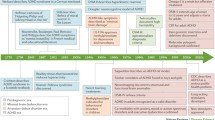Abstract
Attention deficit hyperactivity disorder (ADHD) is a neurodevelopmental disorder characterized by persistent attention deficit, hyperactivity, and impulsivity. The disorder tends to develop before the age of 12. The resulting dysfunction interferes with the quality of social, academic, or workplace functioning, which cannot be explained by other mental disorders or personality disorders. The pathophysiology of ADHD is not well-established. Since ADHD is associated with dopamine and norepinephrine abnormalities, typical treatment strategies include drug therapy (methylphenidate, atomoxetine) combined with cognitive behavioral therapy (CBT), parental training, and other treatments. Predominant drug therapies may lead to adverse reactions such as digestive problems and growth restriction and do not produce a response in some cases. As a result, physical therapy is considered as an alternative option.
Access this chapter
Tax calculation will be finalised at checkout
Purchases are for personal use only
Similar content being viewed by others
References
Allenby C, Falcone M, Bernardo L et al (2018) Transcranial direct current brain stimulation decreases impulsivity in ADHD. Brain Stimul 11(5):974–981
Bandeira ID, Guimarães RS, Jagersbacher JG et al (2016) Transcranial direct current stimulation in children and adolescents with attention-deficit/hyperactivity disorder (ADHD): a pilot study. J Child Neurol 31(7):918–924
Bloch Y, Harel EV, Aviram S et al (2010) Positive effects of repetitive transcranial magnetic stimulation on attention in ADHD Subjects: a randomized controlled pilot study. World J Biol Psychiatry 11(5):755–758
Breitling C, Zaehle T, Dannhauer M et al (2016) Improving interference control in ADHD patients with transcranial direct current stimulation (tDCS). Front Cell Neurosci 10:72
Cao P, Xing J, Cao Y et al (2018) Clinical effects of repetitive transcranial magnetic stimulation combined with atomoxetine in the treatment of attention-deficit hyperactivity disorder. Neuropsychiatr Dis Treat 14:3231–3240
Cosmo C, Baptista AF, de Araújo AN et al (2015) A randomized, double-blind, sham-controlled trial of transcranial direct current stimulation in attention-deficit/hyperactivity disorder. PLoS One 10(8):e013537
Gómez L, Vidal B, Morales L et al (2014) Low frequency repetitive transcranial magnetic stimulation in children with attention deficit/hyperactivity disorder. Preliminary results. Brain Stimul 7(5):760–762
Jacoby N, Lavidor M (2018) Null tDCS effects in a sustained attention task: the modulating role of learning. Front Psychol 9:476
Nejati V, Salehinejad MA, Nitsche MA et al (2020) Transcranial direct current stimulation improves executive dysfunctions in ADHD: implications for inhibitory control, interference control, working memory, and cognitive flexibility. J Atten Disord 24(13):1928–1943
Niederhofer H (2008) Effectiveness of the repetitive transcranial magnetic stimulation (rTMS) of 1 Hz for attention-deficit hyperactivity disorder (ADHD). Psychiatr Danub 20(1):91–92
Niederhofer H (2011) Additional biological therapies for attention-deficit hyperactivity disorder: repetitive transcranial magnetic stimulation of 1 Hz helps to reduce methylphenidate. Clin Pract 2(1):e8
Paz Y, Friedwald K, Levkovitz Y et al (2018) Randomised sham-controlled study of high-frequency bilateral deep transcranial magnetic stimulation (dTMS) to treat adult attention hyperactive disorder (ADHD): negative results. World J Biol Psychiatry 19(7):561–566
Rubia K, Westwood S, Aggensteiner PM et al (2021) Neurotherapeutics for attention deficit/hyperactivity disorder (ADHD): a review. Cell 10(8):2156
Shahar N, Teodorescu AR, Karmon-Presser A et al (2016) Memory for action rules and reaction time variability in attention-deficit/hyperactivity disorder. Biol Psychiatry Cogn Neurosci Neuroimaging 1(2):132–140
Soff C, Sotnikova A, Christiansen H et al (2017) Transcranial direct current stimulation improves clinical symptoms in adolescents with attention deficit hyperactivity disorder. J Neural Transm (Vienna) 124(1):133–144
Soltaninejad Z, Nejati V, Ekhtiari H (2019) Effect of anodal and cathodal transcranial direct current stimulation on DLPFC on modulation of inhibitory control in ADHD. J Atten Disord 23(4):325–332
Sotnikova A, Soff C, Tagliazucchi E et al (2017) Transcranial direct current stimulation modulates neuronal networks in attention deficit hyperactivity disorder. Brain Topogr 30(5):656–672
Ustohal L, Prikryl R, Kucerova HP et al (2012) Emotional side effects after high-frequency rTMS of the right dorsolateral prefrontal cortex in an adult patient with ADHD and comorbid depression. Psychiatr Danub 24(1):102–103
Weaver L, Rostain AL, Mace W et al (2012) Transcranial magnetic stimulation (TMS) in the treatment of attention-deficit/hyperactivity disorder in adolescents and young adults: a pilot study. J ECT 28(2):98–103
Author information
Authors and Affiliations
Editor information
Editors and Affiliations
Rights and permissions
Copyright information
© 2023 The Author(s), under exclusive license to Springer Nature Singapore Pte Ltd.
About this chapter
Cite this chapter
Xue, Q. (2023). Attention Deficit. In: Wang, Y. (eds) Therapeutics of Neural Stimulation for Neurological Disorders. Springer, Singapore. https://doi.org/10.1007/978-981-99-4538-2_16
Download citation
DOI: https://doi.org/10.1007/978-981-99-4538-2_16
Published:
Publisher Name: Springer, Singapore
Print ISBN: 978-981-99-4537-5
Online ISBN: 978-981-99-4538-2
eBook Packages: MedicineMedicine (R0)




